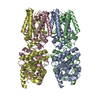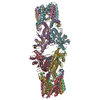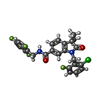+ Open data
Open data
- Basic information
Basic information
| Entry | Database: PDB / ID: 9ct6 | ||||||
|---|---|---|---|---|---|---|---|
| Title | HsSTING with diABZI and C53, apart conformation | ||||||
 Components Components | Stimulator of interferon genes protein | ||||||
 Keywords Keywords | IMMUNE SYSTEM / Innate immunity / membrane protein | ||||||
| Function / homology |  Function and homology information Function and homology informationSTING complex / STAT6-mediated induction of chemokines / protein localization to endoplasmic reticulum / 2',3'-cyclic GMP-AMP binding / cyclic-di-GMP binding / STING mediated induction of host immune responses / serine/threonine protein kinase complex / positive regulation of type I interferon-mediated signaling pathway / IRF3-mediated induction of type I IFN / cGAS/STING signaling pathway ...STING complex / STAT6-mediated induction of chemokines / protein localization to endoplasmic reticulum / 2',3'-cyclic GMP-AMP binding / cyclic-di-GMP binding / STING mediated induction of host immune responses / serine/threonine protein kinase complex / positive regulation of type I interferon-mediated signaling pathway / IRF3-mediated induction of type I IFN / cGAS/STING signaling pathway / proton channel activity / pattern recognition receptor signaling pathway / reticulophagy / cytoplasmic pattern recognition receptor signaling pathway / cellular response to exogenous dsRNA / protein complex oligomerization / autophagosome membrane / positive regulation of macroautophagy / autophagosome assembly / positive regulation of type I interferon production / positive regulation of DNA-binding transcription factor activity / cellular response to interferon-beta / positive regulation of defense response to virus by host / signaling adaptor activity / antiviral innate immune response / endoplasmic reticulum-Golgi intermediate compartment membrane / activation of innate immune response / Regulation of innate immune responses to cytosolic DNA / positive regulation of interferon-beta production / protein serine/threonine kinase binding / autophagosome / cytoplasmic vesicle membrane / secretory granule membrane / SARS-CoV-1 activates/modulates innate immune responses / peroxisome / regulation of inflammatory response / defense response to virus / DNA-binding transcription factor binding / RNA polymerase II-specific DNA-binding transcription factor binding / mitochondrial outer membrane / endosome / cilium / ciliary basal body / Golgi membrane / innate immune response / ubiquitin protein ligase binding / Neutrophil degranulation / endoplasmic reticulum membrane / protein kinase binding / perinuclear region of cytoplasm / SARS-CoV-2 activates/modulates innate and adaptive immune responses / protein homodimerization activity / positive regulation of transcription by RNA polymerase II / nucleoplasm / identical protein binding / plasma membrane / cytosol Similarity search - Function | ||||||
| Biological species |  Homo sapiens (human) Homo sapiens (human) | ||||||
| Method | ELECTRON MICROSCOPY / single particle reconstruction / cryo EM / Resolution: 3.56 Å | ||||||
 Authors Authors | Gharpure, A. / Sulpizio, A. / Lairson, L.L. / Ward, A.B. | ||||||
| Funding support | 1items
| ||||||
 Citation Citation |  Journal: Nat Commun / Year: 2025 Journal: Nat Commun / Year: 2025Title: Distinct oligomeric assemblies of STING induced by non-nucleotide agonists. Authors: Anant Gharpure / Ariana Sulpizio / Johannes R Loeffler / Monica L Fernández-Quintero / Andy S Tran / Luke L Lairson / Andrew B Ward /  Abstract: STING plays essential roles coordinating innate immune responses to processes that range from pathogenic infection to genomic instability. Its adaptor function is activated by cyclic dinucleotide ...STING plays essential roles coordinating innate immune responses to processes that range from pathogenic infection to genomic instability. Its adaptor function is activated by cyclic dinucleotide (CDN) secondary messengers originating from self (2'3'-cGAMP) or bacterial sources (3'3'-CDNs). Different classes of CDNs possess distinct binding modes, stabilizing STING's ligand-binding domain (LBD) in either a closed or open conformation. The closed conformation, induced by the endogenous ligand 2'3'-cGAMP, has been extensively studied using cryo-EM. However, significant questions remain regarding the structural basis of STING activation by open conformation-inducing ligands. Using cryo-EM, we investigate potential differences in conformational changes and oligomeric assemblies of STING for closed and open conformation-inducing synthetic agonists. While we observe a characteristic 180° rotation for both classes, the open-LBD inducing agonist diABZI-3 uniquely induces a quaternary structure reminiscent but distinct from the reported autoinhibited state of apo-STING. Additionally, we observe slower rates of activation for this ligand class in functional assays, which collectively suggests the existence of a potential additional regulatory mechanism for open conformation-inducing ligands that involves head-to-head interactions and restriction of curved oligomer formation. These observations have potential implications in the selection of an optimal class of STING agonist in the context of a defined therapeutic application. | ||||||
| History |
|
- Structure visualization
Structure visualization
| Structure viewer | Molecule:  Molmil Molmil Jmol/JSmol Jmol/JSmol |
|---|
- Downloads & links
Downloads & links
- Download
Download
| PDBx/mmCIF format |  9ct6.cif.gz 9ct6.cif.gz | 634 KB | Display |  PDBx/mmCIF format PDBx/mmCIF format |
|---|---|---|---|---|
| PDB format |  pdb9ct6.ent.gz pdb9ct6.ent.gz | Display |  PDB format PDB format | |
| PDBx/mmJSON format |  9ct6.json.gz 9ct6.json.gz | Tree view |  PDBx/mmJSON format PDBx/mmJSON format | |
| Others |  Other downloads Other downloads |
-Validation report
| Summary document |  9ct6_validation.pdf.gz 9ct6_validation.pdf.gz | 2.5 MB | Display |  wwPDB validaton report wwPDB validaton report |
|---|---|---|---|---|
| Full document |  9ct6_full_validation.pdf.gz 9ct6_full_validation.pdf.gz | 2.6 MB | Display | |
| Data in XML |  9ct6_validation.xml.gz 9ct6_validation.xml.gz | 112.2 KB | Display | |
| Data in CIF |  9ct6_validation.cif.gz 9ct6_validation.cif.gz | 157.1 KB | Display | |
| Arichive directory |  https://data.pdbj.org/pub/pdb/validation_reports/ct/9ct6 https://data.pdbj.org/pub/pdb/validation_reports/ct/9ct6 ftp://data.pdbj.org/pub/pdb/validation_reports/ct/9ct6 ftp://data.pdbj.org/pub/pdb/validation_reports/ct/9ct6 | HTTPS FTP |
-Related structure data
| Related structure data |  45900MC  9ct3C  9ct4C  9ct5C M: map data used to model this data C: citing same article ( |
|---|---|
| Similar structure data | Similarity search - Function & homology  F&H Search F&H Search |
- Links
Links
- Assembly
Assembly
| Deposited unit | 
|
|---|---|
| 1 |
|
- Components
Components
| #1: Protein | Mass: 40246.000 Da / Num. of mol.: 12 Source method: isolated from a genetically manipulated source Source: (gene. exp.)  Homo sapiens (human) / Gene: STING1, ERIS, MITA, STING, TMEM173 / Cell line (production host): HEK 293F / Production host: Homo sapiens (human) / Gene: STING1, ERIS, MITA, STING, TMEM173 / Cell line (production host): HEK 293F / Production host:  Homo sapiens (human) / References: UniProt: Q86WV6 Homo sapiens (human) / References: UniProt: Q86WV6#2: Chemical | ChemComp-A1AZ0 / Mass: 849.937 Da / Num. of mol.: 6 / Source method: obtained synthetically / Formula: C42H51N13O7 / Feature type: SUBJECT OF INVESTIGATION #3: Chemical | ChemComp-9IM / Has ligand of interest | Y | Has protein modification | N | |
|---|
-Experimental details
-Experiment
| Experiment | Method: ELECTRON MICROSCOPY |
|---|---|
| EM experiment | Aggregation state: PARTICLE / 3D reconstruction method: single particle reconstruction |
- Sample preparation
Sample preparation
| Component | Name: Stimulator of interferon genes / Type: COMPLEX / Entity ID: #1 / Source: RECOMBINANT | ||||||||||||||||||||||||||||||
|---|---|---|---|---|---|---|---|---|---|---|---|---|---|---|---|---|---|---|---|---|---|---|---|---|---|---|---|---|---|---|---|
| Molecular weight | Value: 0.40 MDa / Experimental value: NO | ||||||||||||||||||||||||||||||
| Source (natural) | Organism:  Homo sapiens (human) Homo sapiens (human) | ||||||||||||||||||||||||||||||
| Source (recombinant) | Organism:  Homo sapiens (human) / Strain: HEK 293F Homo sapiens (human) / Strain: HEK 293F | ||||||||||||||||||||||||||||||
| Buffer solution | pH: 7.4 | ||||||||||||||||||||||||||||||
| Buffer component |
| ||||||||||||||||||||||||||||||
| Specimen | Conc.: 8 mg/ml / Embedding applied: NO / Shadowing applied: NO / Staining applied: NO / Vitrification applied: YES | ||||||||||||||||||||||||||||||
| Specimen support | Grid material: GOLD / Grid mesh size: 300 divisions/in. / Grid type: UltrAuFoil R1.2/1.3 | ||||||||||||||||||||||||||||||
| Vitrification | Instrument: FEI VITROBOT MARK IV / Cryogen name: ETHANE / Humidity: 100 % / Chamber temperature: 277 K |
- Electron microscopy imaging
Electron microscopy imaging
| Microscopy | Model: TFS GLACIOS |
|---|---|
| Electron gun | Electron source:  FIELD EMISSION GUN / Accelerating voltage: 200 kV / Illumination mode: SPOT SCAN FIELD EMISSION GUN / Accelerating voltage: 200 kV / Illumination mode: SPOT SCAN |
| Electron lens | Mode: OTHER / Nominal magnification: 190000 X / Nominal defocus max: 1500 nm / Nominal defocus min: 600 nm / Cs: 2.7 mm / C2 aperture diameter: 20 µm |
| Specimen holder | Cryogen: NITROGEN |
| Image recording | Average exposure time: 2.2 sec. / Electron dose: 45.07 e/Å2 / Film or detector model: TFS FALCON 4i (4k x 4k) / Num. of real images: 11729 |
- Processing
Processing
| EM software |
| ||||||||||||||||||||||||||||||
|---|---|---|---|---|---|---|---|---|---|---|---|---|---|---|---|---|---|---|---|---|---|---|---|---|---|---|---|---|---|---|---|
| CTF correction | Type: PHASE FLIPPING AND AMPLITUDE CORRECTION | ||||||||||||||||||||||||||||||
| Symmetry | Point symmetry: C1 (asymmetric) | ||||||||||||||||||||||||||||||
| 3D reconstruction | Resolution: 3.56 Å / Resolution method: FSC 0.143 CUT-OFF / Num. of particles: 410899 / Symmetry type: POINT | ||||||||||||||||||||||||||||||
| Atomic model building | Protocol: FLEXIBLE FIT / Space: REAL | ||||||||||||||||||||||||||||||
| Atomic model building | PDB-ID: 7SII Accession code: 7SII / Source name: PDB / Type: experimental model | ||||||||||||||||||||||||||||||
| Refine LS restraints |
|
 Movie
Movie Controller
Controller






 PDBj
PDBj






